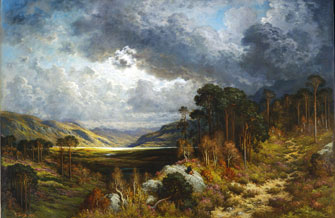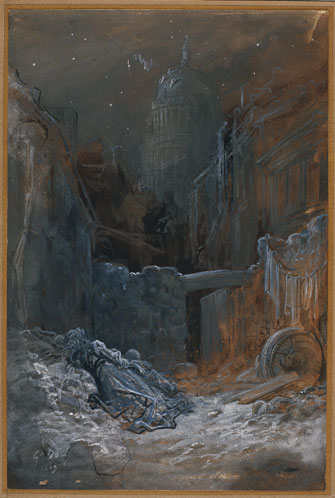The Gilded Life of a
Prolific 19th-Century Artist

Gustave Doré’s “Souvenir de Loch Lamond” (1875). © French & Company, New York
As an artist, Gustave Doré doesn’t fit comfortably into standard categories, which may be why serious 19th-century art critics turned up their noses at his work. Luckily for him, however, the international public liked him better; well enough, in fact, to make him a substantial fortune. The exhibition “Gustave Doré (1832-83): L’imaginaire au Pouvoir” at the Musée d’Orsay shows why.
Born in Strasbourg in 1832, Doré was a child prodigy, already publishing satirical caricatures by the age of 15. A prolific, self-taught artistic polymath, he quickly won acclaim, both in France and abroad, as a book illustrator, draughtsman and engraver. While he is probably best known for his illustrations of the Bible, his work also graced editions of the classics – Dante, Rabelais, La Fontaine, Milton, Shakespeare – as well as works by his contemporaries Hugo, Balzac, Poe and Tennyson.
Over his lifetime, he produced more than 10,000 engravings, illustrating some 4,000 editions. Between 1860 and 1900 a new Doré illustrated edition was published every eight days, according to a Doré biographer, Dan Malan.
Branching out into painting and sculpture, he became one of the principal French painters of mountain scenery. He traveled extensively to the Savoy, the Vosges, Spain, Scotland and especially Switzerland, where he loved to climb. Doré’s influence can be traced in some of the landscapes by Van Gogh, who admired him deeply.
The exhibition, which covers the many different aspects of his art in about 100 works, includes fascinating clips that show how his fantastic imagery has been reprised in films ranging from Jean Cocteau’s Beauty and the Beast to Roman Polanski’s Oliver Twist, Terry Gilliam’s Sleepy Hollow and Cecil B. DeMille’s Ten Commandments, as well as King Kong and Harry Potter films.
The first wide-angle Doré retrospective in 30 years, the exhibition starts on the entry level of the museum with monumental historical and religious oil paintings and Neoclassical-Gothic sculptures.
Doré liked to paint fairgrounds and gypsies – “Les Saltimbanques” (1874), also known as “The Injured Child,” is a fine example. The theme of infernal visions, which also intrigued him throughout his career, is illustrated by the enigmatic painting “Dante’s Hell” (1861). It was works like this that particularly captured the Romantic imagination across Europe and the United States.
The exhibition continues on the fifth floor with drawings, watercolors and smaller works before reaching a triumphant finale in the last room, given over to stunning oil paintings of wild, rugged mountain landscapes, such as “Lake in Scotland: After the Storm” (1875-78).
Stuffy French and English critics disliked him, some because he was too over the top, some because he was too grounded. When, in a neo-Hogarthian mood, he depicted London’s poor in an 1872 guide to the English capital, the Art Journal accused him of “inventing” Hogarthian scenes of poverty in London,

“Poverty in London” (1869). © Photo Musées de Strasbourg
rather than sticking to the “realities” of the capital. The Westminster Review sniffed that Doré “gives us sketches in which the commonest, the most vulgar external features are set down.” And yet, according to his biographer, it was said that you could find a Doré folio in every English-speaking home where the family was literate enough to know how to spell the word “art.”
Musée d’Orsay: 1, rue de la Légion d’Honneur, 75007 Paris. Métro: Solferino. RER: Musée d’Orsay. Tel.: 01 40 49 48 14. Open Tuesday-Sunday, 9:30 a.m.-6 p.m., until 9:45 p.m. on Thursday. Admission: €11. Through May 11, 2014. www.musee-orsay.fr
Reader reaction: Click here to respond to this article (your response may be published on this page and is subject to editing).
Please support Paris Update by ordering books from Paris Update’s Amazon store at no extra cost. Click on your preferred Amazon location: U.K., France, U.S.
More reviews of Paris art shows.
© 2014 Paris Update
Favorite